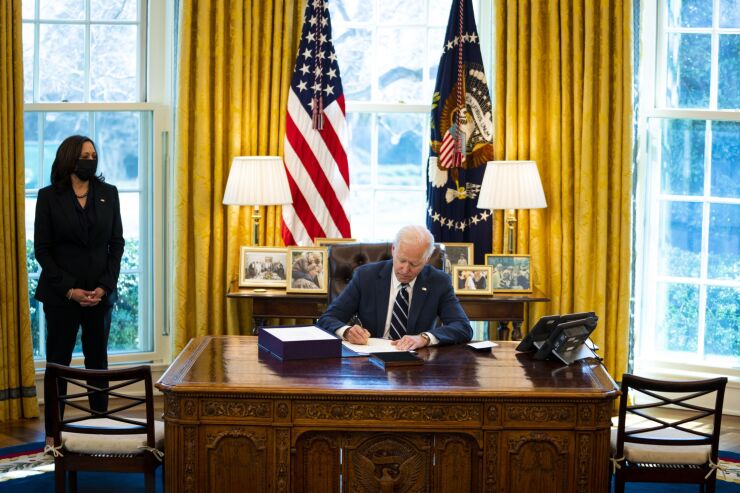The $1.9 trillion COVID relief package signed by President Biden on Thursday isn’t aimed only at lower-income and middle-class individuals. Advisors say that many upper-middle-class earners and even the mass affluent can potentially qualify for a portion of the tax breaks or direct cash payments.
Here’s a cheat sheet to the main personal finance elements tucked into the final American Rescue Plan. Checks are due to start flowing within days of Biden signing the bill.

$1,400 stimulus checks
- A full $1,400 will go to single persons making up to $75,000. For married couples, the income limit is up to $150,000.
- If your client makes more than that amount, their check will be smaller. The payments shrink to zero once a single person makes at least $80,000. For married people, the checks stop at $160,000.
- Fewer individuals will likely end up qualifying because of the swifter phase-out of income levels required to receive a check. The prior two stimulus checks ended once a single person made $100,000 and married couples made $200,000.
- Checks are based on your 2020 federal tax return, if already filed. If not, the Internal Revenue Service will look at the 2019 return.
- People who didn’t get one or more of the first checks but were eligible can claim them as a
credit on their federal returns when filing this tax season. The credit lowers a final tax bill dollar-for-dollar.
- As before, stimulus payments, including the new $1,400, aren’t taxed.
What advisors are saying:
Mark Triplett, the CEO and founder of Triplett-Westendorf Financial Group in Ankeny, Iowa, says that for the $1,400 check, “it’s important to realize the income requirements have changed and will phase out faster than previous rounds.” He recommends that people who get one pay overdue bills, whittle down down high-interest debt, and then make contributions to an existing traditional or Roth IRA before April 15.
Bigger child tax credits = serious money
- The $2,000 Child Tax Credit (CTC) increases dramatically, but temporarily. This year only, it will be $3,600 per child under 6 and $3,000 per child above 6 and under 18. Normally, the credit is for children age 16 and under, so the addition of those age 17 means extra money for some parents.
- Like the limits for the $1,400 stimulus checks, single filers making up to $75,000 and married couples earning up to $150,000 get the full, new credit.
- Those making above those levels would get a
reduced portion of the new credit, with the enhanced benefit phasing out once a single person makes $200,000 or above and married couples earn at least $400,000. Those are also the top amounts that taxpayers can make to claim the regular $2,000 child tax credit.
- Half of the higher credit would go to taxpayers as monthly checks from July through December. The remaining half is claimed on an individual’s tax return filed in 2021. In an
example from Kiplinger, a family of five with three children ages 12, 7 and 5 could get $800 per month from the IRS from July through December, for a total of $4,800. They would then claim the remaining $4,800 when filing their federal return next year.
- The credit lowers an individual’s tax bill dollar-for-dollar. If a person owes zero dollars in tax but still has the credit, it goes back back to the taxpayer as a check.

What advisors are saying:
David Medina, a CFP and the founder of Stewardship Financial in Arcadia, California, called the temporary $3,600 child tax credit for children under 6 a “staggering” one-off sum that can be put to work in a traditional or Roth IRA.
“Younger families stand to benefit immensely,” says Karen Altfest executive vice president of Altfest Personal Wealth Management, an RIA in New York. “For 2021, certain families could see a massive decrease in their tax bill.”
CFP Cheryl Costa, founding principal of Woodside Wealth Management in Framingham, Massachusetts, says that under the new bill, taxpayers earning $440,000 or more will get no child tax credit whatsoever. Previously, those taxpayers were able to claim a partial credit.
Extended unemployment benefits
For individuals or households that made less than $150,000, there’s no federal tax on the first $10,200 of their unemployment benefits received in 2020. All other unemployment benefits are taxable at ordinary rates, including those received this year.
A clutch of regular and special unemployment benefits are extended to Sept. 6. That covers people now getting or expecting soon to receive:
- Traditional state benefits
- The special weekly supplement of $300
- So-called Pandemic Unemployment Assistance for the self-employed, part-time workers and gig workers
- The additional $100 weekly payment, aimed at people who are both self-employed and earn wages through another employer
- Most states tax unemployment benefits. It’s unclear if they will adopt the federal exemption
- The exemption means that people who have already filed their returns this season may need to amend them
What advisors are saying:
“The big change is the tax-free aspect to unemployment benefits,” says Robert Seltzer, a CPA and personal financial specialist (PFS) in Los Angeles, California. While few of his clients claimed those benefits in prior tax seasons, he calls 2020 “a unique year when a far number greater of my clients, who are in the entertainment industry did.”
Costa says that “it appears that if a couple is filing a joint return and both of them were unemployed, each of them could exclude up to $10,200.”
Medina says that the tax exemption for $10,200 in unemployment benefits “could impact middle income and mass affluent families given that over 30 million Americans collected unemployment in 2020.”

Relief on some student loans
- Those who qualify to have their loan forgiven or canceled no longer have to pay income tax on the forgiven debt. The change applies to debt forgiven between Jan. 1, 2020, and year-end 2025.
What advisors are saying:
Costa calls this relief “the granddaddy of all the provisions." While in prior years, forgiven student loan debt was taxed as ordinary income to the individual, “now this debt will not be taxed. This is a big deal for the people who have hundreds of thousands of dollars in debt forgiven.”
More affordable health insurance
COBRA temporarily becomes
Obamacare becomes more affordable. People who bought an Affordable Care Act policy instead of opting for the costly COBRA will see their premiums cost a maximum of 8.5 percent of their income through 2022.
What advisors are saying:
Congress may make some of the changes, including the bigger Child Tax Credit, permanent, writes Jeffrey Levine, a CFP and CFA at accounting and financial advisory firm Kitces, in a





